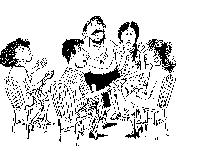Producing information materials can take a long time - you have to write the drafts, edit the text, prepare illustrations and lay out the publication. The resulting prototype is then reviewed by specialists in the subject matter, before final revisions are made. Manuscripts get lost, authors and reviewers may disagree, and people cannot be contacted easily. The process can seem never-ending.
There are several ways of producing information materials. One of these is through writeshops (intensive workshops to write information materials). These are especially useful because they speed up the production and make it far more efficient. The aim is to develop the materials, revise and put them into final form as quickly as possible, taking full advantage of the expertise of the various writeshop participants.
The writeshop process was pioneered at the International Institute of Rural Reconstruction in the Philippines. Writeshops have been used to produce many information materials on various topics relating to various topics related to development.
Writeshop advantages
Writeshop participants may include scientists, researchers, government personnel, teachers, NGO staff, extension agents, farmers and other local people. The diversity of skills, organizations and backgrounds of participants is key to ensuring that numerous ideas are represented in the materials produced. Members of the intended audience (e.g., teachers, farmers and extension personnel) can help pre-test the text and illustrations during the writeshop.
The writeshop process is very different from the scientific conferences familiar to many participants. It is an extremely flexible process. The repeated presentations, critiquing and revision of drafts allow for papers to be reviewed and revised substantially, new topics to be developed during the writeshop and topics to be combined, dropped or split into parts.
Early in the writeshop, the participants brainstorm ideas for new topics (other than those already prepared) that should be part of the publication. These new topics are assigned to knowledgeable participants for development and presentation during the writeshop.
 The writeshop allows inputs from all participants to be incorporated, taking advantage of the diverse experience and expertise of all present. It allows ideas to be validated by a range of experts in the field. The concentration of resource persons, editors, artists and desktop-publishing resources at one time and place enables materials to be produced far more quickly than is typical for similar publications. And the sharing of experiences among participants develops networks that continue to be fruitful long after the writeshop itself.
The writeshop allows inputs from all participants to be incorporated, taking advantage of the diverse experience and expertise of all present. It allows ideas to be validated by a range of experts in the field. The concentration of resource persons, editors, artists and desktop-publishing resources at one time and place enables materials to be produced far more quickly than is typical for similar publications. And the sharing of experiences among participants develops networks that continue to be fruitful long after the writeshop itself.
The publication
The publication resulting from the writeshop can be in any of a range of formats: loose-leaf, a set of pocket-sized booklets, or a bound book. The format and design can be set beforehand - or decided by the participants during the writeshop itself.
The broad theme is divided into smaller topics, each of which is based on a manuscript prepared by a writeshop participant. Some examples:
- Storing seeds (in a booklet on agroforestry)
- Wounds and burns (in a book on traditional veterinary medicine in Kenya)
- Growing cardamom (one of a series of extension leaflets on upland agriculture in Vietnam).
Each topic contains line drawings or photographs to illustrate key points. The illustrations are drawn during the writeshop itself, and participants are asked to check the drawings for accuracy and ease of understanding. Participants bring photographs with them to select during the writeshop itself.
The publication contains only relevant and practical information. It is not a vehicle for lengthy literature reviews or for presentation of unnecessarily detailed data. Whenever possible, it provides technological options that show more than one way of doing the same thing.
More information
- Ballantyne, Peter. 2014. An innovation platform writeshop: Capturing and scaling out learning. International Livestock Research Institute, Nairobi
- The Livelihood School. 2013. Writeshops. The Livelihood School, Hyderabad, India
- The Livelihood School. 2013. The writeshop approach. Four-part video presentation by S.S. Tabrez Nasar. The Livelihood School, Hyderabad, India.
- Mundy, Paul. 2010. Writeshops, oh writeshops (poem) PowerPoint or PDF
- Mundy, Paul. 2010. Adapting the writeshop process. PowerPoint
- Mundy, Paul. 2010. Using writeshops to produce policy briefs. PowerPoint presentation
- Mundy, Paul. 2010. Training writeshops: Using writeshops to teach writing. Poster
- Mundy, Paul, and Anna K. Lindqvist. 2010. Writing clinics: Writeshops without presentations. Poster.
- Julian Gonsalves and Ric Armonia (editors). 2010. Writeshops. A tool for packaging and sharing field-based experiences. International Institute of Rural Reconstruction and International Potato Center - UPWARD.
- Shortdoc writeshop. Video by Anna Laven of the Royal Tropical Institute on a writeshop to produce a book on value chain finance. 6.41 minutes
- Mundy, Paul, Evelyn Mathias and Isaac Bekalo. 2006. Out of heads and onto paper. LEISA Magazine 22(1)
- Mundy, Paul, and Evelyn Mathias. 1997. Participatory workshops to produce information materials on ethnoveterinary medicine. Paper presented at the First International Conference on Ethnoveterinary Medicine, Pune, India, 4–6 November 1997
- Mundy, Paul. Producing information materials through participatory workshops
- Chavez, H de, D Campilan, J Gonsalves and J Rivaca. 2006. Communicating science to support conservation and use of agricultural biodiversity: A case study. Users’ Perspectives With Agricultural Research and Development - International Potato Center (CIP-UPWARD). Summary at pp 246, 236 in: Donghong Cheng, Jenni Metcalfe and Bernard Schiele (eds). 2006. At the human scale: International practices in science communication. Science Press, China. 351p. ISBN 7-03-017069-5
- National Agriculture and Forestry Research Institute. 2004. Improving livelihoods in the uplands of the Lao PDR: A Sourcebook. NAFRI, Vientiane, Laos
